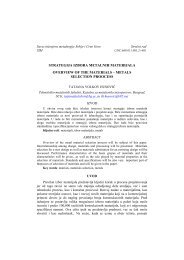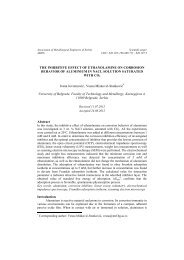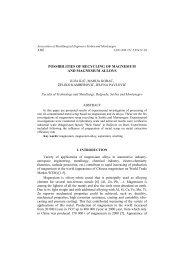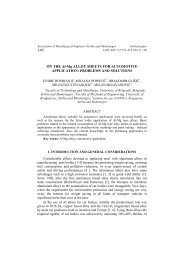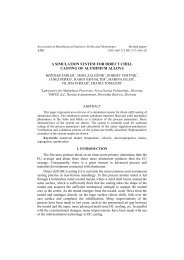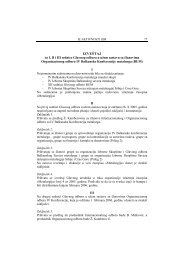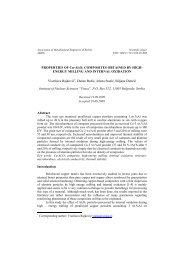ferrous metallurgy center of the brnjica cultural group - CEON
ferrous metallurgy center of the brnjica cultural group - CEON
ferrous metallurgy center of the brnjica cultural group - CEON
Create successful ePaper yourself
Turn your PDF publications into a flip-book with our unique Google optimized e-Paper software.
Association <strong>of</strong> Metallurgical Engineers <strong>of</strong> Serbia<br />
AME<br />
Scientific paper<br />
UDC:669.1”639-14-13”(497.11)=20<br />
FERROUS METALLURGY CENTER OF THE BRNJICA<br />
CULTURAL GROUP (14 th –13 th CENTURIES BC) AT THE<br />
HISAR SITE IN LESKOVAC<br />
MILORAD STOJIĆ<br />
The Institute <strong>of</strong> Archaeology, Belgrade, Serbia<br />
ABSTRACT<br />
The remains <strong>of</strong> <strong>the</strong> <strong>ferrous</strong> <strong>metallurgy</strong> and handicrafts <strong>center</strong> based on iron from <strong>the</strong><br />
oldest Brnjica <strong>cultural</strong> <strong>group</strong> stage (<strong>the</strong> 14 th –13 th centuries BC) were discovered in one<br />
part <strong>of</strong> <strong>the</strong> archaeological Hisar site in Leskovac; found are: millstones (several<br />
hundreds), smelting furnaces (dozens), charcoal pits, air blowing ceramic pipes, slag,<br />
amorphous iron, bloom and o<strong>the</strong>r <strong>ferrous</strong> artefacts.<br />
Key words: iron, furnaces, slag, <strong>ferrous</strong> artifacts, Brnjica culture<br />
The experts in archaeo<strong>metallurgy</strong> deny existence <strong>of</strong> iron production in<br />
Europe prior to <strong>the</strong> first millennium BC maintaining that <strong>the</strong> <strong>ferrous</strong> artefacts<br />
from <strong>the</strong> last centuries <strong>of</strong> <strong>the</strong> second millennium BC, found within <strong>the</strong> territory<br />
<strong>of</strong> <strong>the</strong> continent, were made <strong>of</strong> raw material imported from <strong>the</strong> Middle East (by<br />
“alloy circulation”) or that <strong>the</strong>y stem from meteoric iron [1]. The archaeological<br />
research, however, proved <strong>the</strong> existence <strong>of</strong> <strong>the</strong> <strong>ferrous</strong> <strong>metallurgy</strong> <strong>center</strong> at <strong>the</strong><br />
Brnjica site Hisar in Leskovac dating <strong>the</strong> 14 th –13 th centuries BC (Figure 1) [2].<br />
Given <strong>the</strong> fact that several <strong>ferrous</strong> artefacts from <strong>the</strong> period <strong>of</strong> 14 th –13 th<br />
(12 th ) centuries BC were discovered within <strong>the</strong> central Balkan territory prior to<br />
2005, until that year <strong>the</strong>re were no pro<strong>of</strong>s <strong>of</strong> existence <strong>of</strong> possible local<br />
<strong>metallurgy</strong> <strong>of</strong> iron [3]. The discovery <strong>of</strong> a big iron needle at <strong>the</strong> Hisar site in<br />
Leskovac stimulated even more <strong>the</strong> archaeological research <strong>of</strong> <strong>metallurgy</strong> <strong>of</strong><br />
iron.<br />
Fig 1
106<br />
MJoM<br />
METALURGIJA - JOURNAL OF METALLURGY<br />
Namely, several months after <strong>the</strong> trial archaeological excavations in 2000 at<br />
<strong>the</strong> Hisar site in Leskovac, which served to substantiate <strong>the</strong> complete<br />
development <strong>of</strong> <strong>the</strong> Brnjica <strong>cultural</strong> <strong>group</strong> (<strong>the</strong> 14 th –10 th centuries BC) in <strong>the</strong><br />
South Morava river basin, an associate from <strong>the</strong> Leskovac Museum, who had<br />
taken part in <strong>the</strong> excavations, found at <strong>the</strong> bottom <strong>of</strong> <strong>the</strong> excavation pr<strong>of</strong>ile from<br />
<strong>the</strong> mentioned year, a 0.645 m long <strong>ferrous</strong> artefact in a form <strong>of</strong> a needle,<br />
(Figure 2) [4]. “The needle” has irregular biconical head with largest width <strong>of</strong><br />
0.021 m, mildly bent neck <strong>of</strong> ca. 0.006 m in diameter connected to a part <strong>of</strong><br />
0.007 m wide square cross section, while <strong>the</strong> remaining part, in direction <strong>of</strong> <strong>the</strong><br />
point, has a diameter between 0.005 and 0.002 m. The head is wrought crudely<br />
and is <strong>of</strong> irregular form. The swelling <strong>of</strong> <strong>the</strong> “needle”, <strong>of</strong> square cross section,<br />
has a very symmetrical form. There are no visible traces <strong>of</strong> corrosion on this<br />
artefact. By a method <strong>of</strong> energetic dispersion X-fluorescent spectroscopy it is<br />
established that <strong>the</strong> needle was made <strong>of</strong> iron with no traces <strong>of</strong> any o<strong>the</strong>r metals.<br />
The X-ray shows <strong>the</strong> needle to be made <strong>of</strong> very compact iron. In short, this<br />
artefact was made <strong>of</strong> very compact iron with no traces <strong>of</strong> o<strong>the</strong>r metals and has<br />
not shown any signs <strong>of</strong> corrosion both during <strong>the</strong> period <strong>of</strong> burial in <strong>the</strong> ground<br />
and later on.<br />
Fig. 2<br />
The archaeological excavations carried out in 2003 showed that <strong>the</strong> iron needle<br />
(Turović’s needle) found in 2000, comes from a large architectural structure from<br />
<strong>the</strong> 14 th or 13 th centuries BC in <strong>the</strong> <strong>center</strong> <strong>of</strong> which was a large furnace and a great<br />
number <strong>of</strong> millstones with traces <strong>of</strong> ore grinding (iron?) [5]. The analyses showed<br />
that <strong>the</strong> furnace was not used for food preparation, but most likely for iron smelting,<br />
because no animal bones or fruits remnants were found, but for amorphous iron<br />
pieces, slag and air blowing ceramic pipes [6].<br />
During <strong>the</strong> archaeological excavations in 2005 at <strong>the</strong> same Hisar site in<br />
Leskovac, five o<strong>the</strong>r <strong>ferrous</strong> artefacts were found: three (<strong>of</strong> which two were chisels<br />
and a needle fragment with an oval head) in an architectural structure from <strong>the</strong><br />
oldest stage <strong>of</strong> <strong>the</strong> Brnjica <strong>cultural</strong> <strong>group</strong> (<strong>the</strong> middle <strong>of</strong> <strong>the</strong> 14 th century BC) –
FERROUS METALLURGY CENTER OF THE BRNJICA CULTURAL ... 107<br />
(Figures 3–5), one (iron–bronze combination) under a furnace calotte and a 3340 g.<br />
cast in a Brnjica <strong>cultural</strong> <strong>group</strong> layer, characterized specially by <strong>the</strong> Mycenaean style<br />
painted ceramics (Figure 6). In 2005, several kilometers to <strong>the</strong> southwest from <strong>the</strong><br />
Brnjica metallurgic <strong>center</strong>, at <strong>the</strong> Hisar site in Leskovac, ano<strong>the</strong>r needle was found,<br />
same by type, but somewhat shorter than <strong>the</strong> 2000 find (Figure 7). In <strong>the</strong> close<br />
vicinity <strong>of</strong> <strong>the</strong> slag filled structure (where <strong>the</strong> three <strong>ferrous</strong> artefacts were found)<br />
were found remains <strong>of</strong> dozens <strong>of</strong> furnaces (Figures 8–9) among which is <strong>the</strong> furnace<br />
under calotte <strong>of</strong> which was found <strong>the</strong> artefact made in <strong>the</strong> iron–bronze combination.<br />
Fig. 3 Fig. 4 Fig. 5<br />
Fig. 5a Fig. 6<br />
Fig. 7<br />
Fig. 8 Fig. 9
108<br />
MJoM<br />
METALURGIJA - JOURNAL OF METALLURGY<br />
Fig 10<br />
In short, during <strong>the</strong> archaeological excavations in <strong>the</strong> part <strong>of</strong> <strong>the</strong> Hisar site in<br />
Leskovac, in <strong>the</strong> oldest stratum <strong>of</strong> <strong>the</strong> Brnjica <strong>cultural</strong> <strong>group</strong> (<strong>the</strong> middle <strong>of</strong> <strong>the</strong> 14 th<br />
century BC) were found: <strong>ferrous</strong> cast <strong>of</strong> several kilograms, amorphous iron, <strong>ferrous</strong><br />
artefacts, slag, remains <strong>of</strong> numerous smelting furnaces, charcoal pits, ceramic air<br />
blowing pipes (Figure 10), millstones with traces <strong>of</strong> ore grinding; consequently, all<br />
<strong>the</strong> finds confirm <strong>the</strong> existence <strong>of</strong> a <strong>ferrous</strong> <strong>metallurgy</strong> and handicrafts <strong>center</strong> at <strong>the</strong><br />
Hisar site, based on iron.<br />
The <strong>ferrous</strong> artefacts in a form <strong>of</strong> “shafts” or “spits”, similar to <strong>the</strong> “needles”<br />
from <strong>the</strong> Hisar site in Leskovac, found in larger numbers at one spot (<strong>the</strong> Lower<br />
Danube, Peloponnesus, Middle East) are considered to represent <strong>the</strong> (pre–monetary)<br />
payment means, expensive presents or, possibly, votive presents [7]. The oldest<br />
<strong>ferrous</strong> artefacts in <strong>the</strong> Middle East very <strong>of</strong>ten are in a form <strong>of</strong> a chisel, similar to <strong>the</strong><br />
chisel from <strong>the</strong> Hisar slag structure [8]. The iron production in <strong>the</strong> Middle East<br />
during <strong>the</strong> second half <strong>of</strong> <strong>the</strong> second millennium BC, as well as <strong>the</strong> distribution<br />
<strong>the</strong>re<strong>of</strong>, particularly <strong>of</strong> finished artefacts, was under <strong>the</strong> strict control <strong>of</strong> rulers, as<br />
confirmed in <strong>the</strong> written documents <strong>of</strong> <strong>the</strong> time [9]. It may be assumed that <strong>the</strong>re<br />
was no kept evidence <strong>of</strong> <strong>the</strong> “royal metal” expenditures at <strong>the</strong> Hisar settlement in<br />
Leskovac, that <strong>the</strong>re was no iron inventory as had been kept by <strong>the</strong> Hittites or <strong>the</strong><br />
Assyrians, but it is quite certain that <strong>the</strong> leading personality <strong>of</strong> <strong>the</strong> South Morava<br />
river basin society living in <strong>the</strong> settlement, had taken care <strong>of</strong> <strong>the</strong> production and<br />
distribution <strong>of</strong> iron and <strong>ferrous</strong> artefacts as well as that he had seen to it that <strong>the</strong><br />
metallurgic secret <strong>of</strong> production <strong>of</strong> <strong>the</strong> “metal, more expensive than gold” remained<br />
under his monopoly, <strong>the</strong> same as had done <strong>the</strong> powerful Hittite and Mesopotamian<br />
rulers.<br />
The Rajkinac axe, <strong>ferrous</strong> artefacts traces from Stari Kostolac, <strong>the</strong> iron fibula<br />
from <strong>the</strong> Gornja Stražava urn and <strong>the</strong> <strong>ferrous</strong> artefacts from Leskovac are <strong>the</strong> oldest<br />
<strong>ferrous</strong> artefacts in <strong>the</strong> central Balkan region, pointing to <strong>the</strong> fact that iron was<br />
utilized by all <strong>the</strong> communities from <strong>the</strong> area during <strong>the</strong> 14 th –13 th (12 th ) centuries BC<br />
[10]. All <strong>the</strong> <strong>ferrous</strong> artefacts have <strong>cultural</strong> and chronologic context. The Rajkinac<br />
axe belongs to <strong>the</strong> Paraćin <strong>cultural</strong> <strong>group</strong>, Leskovac and Gornja Stražava artefacts –<br />
to <strong>the</strong> Brnjica <strong>cultural</strong> <strong>group</strong>, while <strong>the</strong> Stari Kostolac artefacts – belong to <strong>the</strong><br />
Belegiš II <strong>cultural</strong> <strong>group</strong>, that is, most probably to <strong>the</strong> <strong>cultural</strong> manifestation<br />
characterized by a mixture <strong>of</strong> yellow hill ceramics and cannelured ceramics <strong>of</strong><br />
Belegiš II type – Gava. In short, <strong>the</strong>se artefacts prove <strong>the</strong> use <strong>of</strong> <strong>ferrous</strong> artefacts <strong>of</strong><br />
all <strong>the</strong> central Balkan communities during <strong>the</strong> period <strong>of</strong> 14 th –13 th (12 th ) centuries<br />
BC.
FERROUS METALLURGY CENTER OF THE BRNJICA CULTURAL ... 109<br />
The context (grave finds) <strong>of</strong> individual artefacts point out that <strong>the</strong> <strong>ferrous</strong><br />
products were exceptionally appreciated during <strong>the</strong> 14 th –13 th centuries BC in <strong>the</strong><br />
Pomoravlje region (along <strong>the</strong> Morava rivers), not only as expensive products but as<br />
objects <strong>of</strong> definite symbolic meaning.<br />
Hisar in Leskovac was <strong>the</strong> only settlement within <strong>the</strong> central Balkan region<br />
from <strong>the</strong> period <strong>of</strong> <strong>the</strong> 14 th –13 th centuries BC with a fortification – an acropolis <strong>of</strong><br />
several hectares <strong>of</strong> land. Its location (at <strong>the</strong> crossing points <strong>of</strong> roads leading along<br />
<strong>the</strong> Jablanica and Veternica rivers’ valleys and along <strong>the</strong> Morava river valley), its<br />
size (<strong>of</strong> several hectares), its continuity (14 th –13 th centuries BC), permanent<br />
development, specialized features <strong>of</strong> individual parts <strong>of</strong> <strong>the</strong> settlement (acropolis,<br />
metallurgic <strong>center</strong>, bone processing <strong>center</strong>, representative architecture (habitations<br />
decorated in Mycenaean style plastics), variety <strong>of</strong> ceramics (diverse forms,<br />
extraordinary quality, richness <strong>of</strong> decoration, Mycenaean style imitations), – all <strong>of</strong><br />
<strong>the</strong>se confirm that <strong>the</strong> settlement at <strong>the</strong> Hisar location in Leskovac was <strong>the</strong> most<br />
representative one and undoubtedly <strong>the</strong> main settlement <strong>of</strong> <strong>the</strong> Brnjica community,<br />
<strong>the</strong> largest and <strong>the</strong> only one artificially fortified settlement within <strong>the</strong> whole central<br />
Balkan region during <strong>the</strong> last centuries <strong>of</strong> <strong>the</strong> second millennium BC.<br />
The settlement, being <strong>the</strong> largest within <strong>the</strong> whole central Balkan region, as<br />
already emphasized, distinguishes itself by two characteristics. It has its fortification<br />
– acropolis, protected by a moat and a rampart, its bronze and iron metallurgic and<br />
handicrafts <strong>center</strong>s and a separate bone processing <strong>center</strong>. In all cultures and periods<br />
<strong>of</strong> time, metallurgic <strong>center</strong>s, particularly <strong>the</strong> iron ones, were under <strong>the</strong> protection <strong>of</strong><br />
fortified palaces i.e. <strong>of</strong> fortifications.<br />
The earliest iron <strong>metallurgy</strong> (in <strong>the</strong> second half <strong>of</strong> <strong>the</strong> second millennium BC)<br />
in <strong>the</strong> Middle East was carried out explicitly under <strong>the</strong> auspices <strong>of</strong> <strong>the</strong> capital <strong>of</strong> <strong>the</strong><br />
state and <strong>the</strong> ruling palace [11]. The Hisar settlement in Leskovac from <strong>the</strong> second<br />
half <strong>of</strong> <strong>the</strong> second millennium BC reproduces <strong>the</strong> same pattern.<br />
It might be supposed that knowledge <strong>of</strong> iron <strong>metallurgy</strong> arrived to Pomoravlje<br />
from <strong>the</strong> Mycenaean area, <strong>the</strong> same as <strong>the</strong> influences manifested in <strong>the</strong> architectural<br />
plastics (to be found at Hisar) as well as in painted ceramics. The Mycenaean<br />
civilization reached its culmination in <strong>the</strong> 14 th –13 th centuries BC, greatly because <strong>of</strong><br />
<strong>the</strong> monopoly both <strong>of</strong> production and distribution <strong>of</strong> bronze artefacts across <strong>the</strong><br />
significant part <strong>of</strong> <strong>the</strong> Mediterranean. On Mycenaean territory were found <strong>ferrous</strong><br />
artefacts, but <strong>the</strong>re is no pro<strong>of</strong> <strong>of</strong> local <strong>metallurgy</strong> <strong>of</strong> <strong>the</strong> metal, which makes it<br />
certain that <strong>the</strong>se <strong>ferrous</strong> artefacts were imported from <strong>the</strong> Middle East (<strong>the</strong> same as<br />
in Egypt) [12]. It seems, however, that <strong>the</strong> <strong>ferrous</strong> artefacts stemming from <strong>the</strong><br />
Mycenaean soil are younger as compared to <strong>the</strong> <strong>ferrous</strong> artefacts belonging to <strong>the</strong><br />
Brnjica <strong>cultural</strong> <strong>group</strong> from Pomoravlje. Moreover, it seems that <strong>the</strong> Mycenaean<br />
interest for some communities in Pomoravlje, such as <strong>the</strong> one belonging to <strong>the</strong><br />
settlement in Leskovac, proved by architectural plastics and painted ceramics – was<br />
at least partly motivated by possibility to acquire iron. Even if <strong>the</strong> Mycenaean<br />
community had <strong>the</strong> knowledge to produce iron, it was much easier for <strong>the</strong>m to get it<br />
through barter from outside than to produce it on its own soil because <strong>of</strong> <strong>the</strong><br />
energetic shortage (lack <strong>of</strong> wood) <strong>of</strong> <strong>the</strong> civilization from <strong>the</strong> south <strong>of</strong> <strong>the</strong> Balkan<br />
Peninsula.<br />
There are reliable pro<strong>of</strong>s <strong>of</strong> iron utilization by all <strong>the</strong> central Balkan<br />
communities as well as that <strong>the</strong> Brnjice community, as already mentioned, mastered<br />
<strong>the</strong> iron <strong>metallurgy</strong> and handicrafts based on this metal in its early stage (ca. 1350<br />
BC) [13]. Moreover, all <strong>ferrous</strong> artefacts found in <strong>the</strong> central Balkan region come
110<br />
MJoM<br />
METALURGIJA - JOURNAL OF METALLURGY<br />
from enclosed entities – graves and depositories or from layers, <strong>the</strong> relative<br />
chronology <strong>of</strong> which is determined precisely [14].<br />
The Rajkinac axe, <strong>ferrous</strong> artefacts traces from Stari Kostolac and <strong>the</strong> <strong>ferrous</strong><br />
artefacts from Leskovac and Gornja Stražava are <strong>the</strong> oldest <strong>ferrous</strong> artefacts in <strong>the</strong><br />
central Balkan region. All <strong>the</strong> artefacts have <strong>the</strong>ir <strong>cultural</strong> and chronological context.<br />
The Rajkinac axe belongs to <strong>the</strong> Paraćin <strong>cultural</strong> <strong>group</strong>, Leskovac and Gornja<br />
Stražava to <strong>the</strong> Brnjica <strong>cultural</strong> <strong>group</strong>; <strong>the</strong> Stari Kostolac artefacts belong to <strong>the</strong><br />
Belegiš II <strong>cultural</strong> <strong>group</strong> – Gava.<br />
The <strong>ferrous</strong> artefacts from Pomoravlje from <strong>the</strong> period <strong>of</strong> <strong>the</strong> 14 th –13 th centuries<br />
BC and particularly, <strong>the</strong> existence <strong>of</strong> <strong>the</strong> <strong>ferrous</strong> <strong>metallurgy</strong> <strong>center</strong> from <strong>the</strong> 14 th<br />
century BC within <strong>the</strong> framework <strong>of</strong> <strong>the</strong> sole artificially fortified settlement in <strong>the</strong><br />
central Balkan region – on <strong>the</strong> Hisar site in Leskovac, point to <strong>the</strong> region which had<br />
a definite, and possibly <strong>the</strong> crucial part in <strong>the</strong> far-reaching events designated as <strong>the</strong><br />
Aegean migration.<br />
REFERENCES<br />
[1] R. Pleiner, Iron In Archaeology, The European Bloomery Smelters, Praha, (2000),<br />
23 – 35.<br />
[2] The first research results <strong>of</strong> <strong>the</strong> <strong>ferrous</strong> <strong>metallurgy</strong> <strong>center</strong> remains at <strong>the</strong> Hisar site<br />
in Leskovac are being published in this article.<br />
[3] M. Stojić, Najstariji nalazi gvozdenih predmeta u Srbiji (The oldest finds <strong>of</strong> <strong>ferrous</strong><br />
artefacts in Serbia), Godišnjak (The Annual Review), XXXII, (2002),<br />
Balkanologic Research Center, 30, Sarajevo – Frankfurt am Main – Berlin -<br />
Heidelberg<br />
[4] M. Stojić, Najstariji nalazi gvozdenih predmeta u Srbiji (The oldest finds <strong>of</strong> <strong>ferrous</strong><br />
artefacts in Serbia), Godišnjak (The Annual Review), XXXII, (2002),<br />
Balkanologic Research Center, 30, Sarajevo – Frankfurt am Main – Berlin –<br />
Heidelberg , 235 and fur<strong>the</strong>r on<br />
[5] Not published, <strong>the</strong> archaeological artefacts and documentation are safeguarded in<br />
<strong>the</strong> National Museum in Leskovac<br />
[6] Expert findings made by S. Blažić, paleozoologist, and A. Medović,<br />
arhaeoagronomist; documentation is safeguarded in <strong>the</strong> Archaeological Institute in<br />
Belgrade, not published.<br />
[7] Pleiner, Ibid, 9-10, 14, 20<br />
[8] Ibid, 20<br />
[9] Ibid, 10, 16, 18, 20<br />
[10] D. Krstić, Preistorijske nekropole u Gornjoj Stražavi (Prehistoric necropolis in<br />
Gornja Stražava), Zbornik Narodnog Muzeja (National Museum Reports Book),<br />
14th–1, (1991), 240, T.IX/1 a–b; M. Stojić, Najstariji nalazi gvozdenih predmeta u<br />
Srbiji (The oldest <strong>ferrous</strong> artefacts finds in Serbia), Godišnjak (Annual Report<br />
Book), XXXII, (2002), Balkanologic Research Center, 30, Sarajevo – Frankfurt am<br />
Main – Berlin – Heidelberg<br />
[11] Ibid, 10, 16, 18, 20<br />
[12] 7–8, 10<br />
[13] M. Stojić, Ibid.<br />
[14] Ibid, 235




